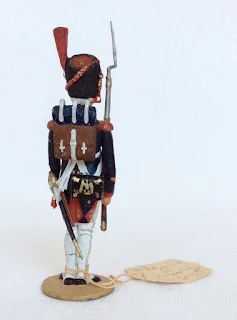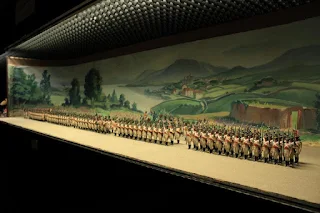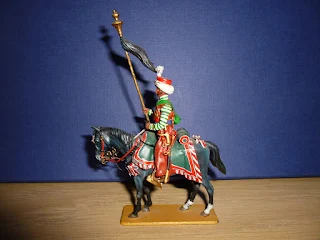During the entire span of the Arnhem Jim blog the most frequently occurring search keywords have been “metayer toy soldiers”, with people looking for any information on the figures of Madame Fernande Metayer.
Primarily a collector of the relatively more common and mundane W. Britains Ltd. toy soldiers, I was unfortunately ignorant of her magnificent efforts. They are truly “objects d’art”. What follows are the results of my research on her figures.
Madame Metayer actively produced connoisseur figures from the 1940’s through the 1970’s. Born in 1911 she lived to the age of 101, passing away on 13 December 2012. She only modeled exclusive 54mm foot figures and never duplicated the features on a particular model, each one is therefore unique. The clothing & equipment for each figure is made from sculpted sheet lead soldered in place and then detailed. These French Napoleonic Infantry figures are now EXTREMLEY RARE and seldom come to the open market.
In her own words Mme. Metayer explains how she started producing her figurines, "I was widowed during the war (World War II). I was not trained for anything: I was a typical example of a well-brought-up young lady who played the piano, painted in watercolours and embroidered. It was my painting which hinted at a possible solution for me: model soldiers. I started to do some research and to design them and I found a sculptor who could complete my designs for me. I was lucky. My 'little men travel all over Europe, to America, particularly to the museums."
The following excerpts of a journalist’s conversation with Madame Metayer in December 1959; “Mme. Fernande Metayer, who has been the leading creator of figurines since 1930, started out as a painter of miniatures. At the suggestion of a friend, she tried her hand at making toy soldiers. She never painted another miniature after starting on the soldiers. "It is so much more diverting," she explains, "although the work does take a great deal of research, considering that the tiniest detail has to be correct." Madame Metayer says it is difficult to estimate how long it takes to complete a figurine. "I work on several at a time," she says, "if only to escape monotony. For example, the coach in which Napoleon rode to his crowning at Notre Dame must have taken many, many hours. The horse reins are threaded through rings no bigger than the eye of a darning needle." Mme. Metayer, who ships her products to the four corners of the earth, conveniently forgets the names of many of her best clients. Most of the important collectors prefer, for tax purposes, to remain anonymous. The reason being that in many countries toy soldier collections are looked upon as works of art and the owners of such collections are taxed accordingly.”
Marcel Baldet (1898-1972) who wrote one of the classic books on toy soldiers and military miniatures, Figurines et Soldats de Plomb, Paris, 1961 (Lead Soldiers and Figurines, The World in Miniatures, M. Baldet, Crown Publishers, New York, N.Y., 1961), was also a distinguished maker in his own right. Each of his figures, like those of Mme. Metayer, was one of a kind, made by hand. Although relatively obscure, his book which is a useful reference, is still available from used book dealers at a very reasonable price range of $8.00 - $12.00 USD. Dioramists will find his chapter devoted to the subject particularly enlightening.
“ In due course, there appeared another innovation, ronde-bosse (three-dimensional) figurines manufactured expressly for collectors. After long and careful study of the problem, Mme. F. Metayer developed from drawings made by Lucien Rousselot, the first examples of here “Little Soldiers of France”, a series devoted to the First Empire. Success was assured at the very outset by the care bestowed on every detail of mold making, casting, and assembly, and by the wisdom of Fernande Metayer, a painter whose work has stood the test of time."
It is at this time that the figurine makers became fascinated with “individualism”, ever an important factor in artistic achievement. There developed a recognized urge to create a thing that waqs different, or at least different in form, from the work of one’s colleagues.”
With both full acknowledgement and gratitude to Monsieur Phillipe Lancredore, the images that follow are Mme. Metayer's depiction of one of the most colorful units of the Napoleonic army. The Mamelukes were colonial troops from Egypt, and served as part of the Imperial Guard (Escadron de Mamelukes de la Garde Imperiale). In addition they often served as musicians in regimental bands. The first figurine is a Cavalier Mameluck Timbalier (Kettle drummer), and the second a Cavalier Mameluck Porte Toug (Standard bearer). Monsr. Lancredore himself has a very interesting background, in addition to his interest in military miniatures, he served 15 years in the 1er regiment d'infanterie de marine (1er RIMa) (armee de terre) (the French Marine Corps).
The following contemporary print of a Mameluke reflects the accuracy of Mme. Metayer's research and comprehensive level of detail incorporated into her figurines.



























1 comment:
Back about 1950 I was visiting New York with my mother and she left me in a store on north Lexington Ave called "Military Miniatures." They had glass display counters and down inside were handmade soldiers by the hundreds. When my mother returned I persuaded her to endorse my order, which was for the custom casting of a set of US Civil War canoneers, Union and Confederacy, five or six of each, to be supplied by Mme Metayer in France. The Union gunners were to be serving their cannon. The Confederates were to be dead or dying, lying about their broken canon--all with swabs and buckets and balls. I have photos. And I am looking for a buyer. Please use my regular email: fjjwagner at yahoo dot com.
Post a Comment